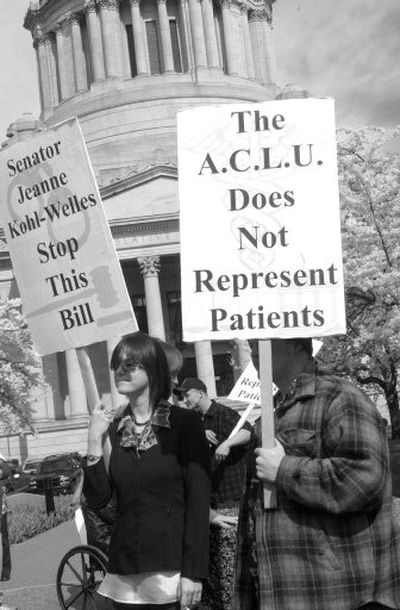Medical marijuana bill stirs debate

OLYMPIA – In 1998, Washington voters approved an initiative allowing seriously ill patients to use marijuana.
But nine years later, lawmakers are still working out the details. How much marijuana is allowed? Where are patients supposed to get it? And what is their doctors’ role in all this, given that the federal government still considers marijuana an illegal drug?
A bill that attempts to address some of those questions attracted a demonstration and standing-room-only crowd Monday for a hearing before the House Health Care and Wellness Committee.
Patients lined up on both sides of the measure, with supporters saying it’s important to clarify an ambiguous law. Critics urged lawmakers to block the bill, in part because of a provision that directs the state Department of Health to determine how much marijuana constitutes the “60-day supply” deemed legal for patients under the law.
“That’s up to my doctor and myself,” said Steve Sarich, executive director of CannaCare, a group that advocates on behalf of medical marijuana patients. “How can the Department of Health decide how much medication I need?”
Supporters of the bill, Senate Bill 6032, said having the state define a 60-day supply would give patients and law enforcement officers some guidelines, and patients could petition to be allowed to have more.
“My intent here is to have some clarification made to the statute, because there are some ambiguities that have made things difficult for patients,” said Jeanne Kohl-Welles, D-Seattle.
The bill passed the Senate.
In addition to asking the Department of Health to define a 60-day supply, the measure would allow police to take a sample – rather than a patient’s entire supply – to determine whether the person is, indeed, a legal user of the drug. It would also add some diseases, such as Crohn’s disease and hepatitis C, to the list of afflictions that can be treated with marijuana.
Earlier versions of the bill also included provisions that allowed for marijuana growing co-operatives and protected health care providers from criminal and civil penalties. The elimination of those provisions angered critics, who say that medical marijuana patients in Washington are routinely prosecuted unfairly.
“There is nothing in this bill that protects us from that happening,” said Sarich, who told the committee a “rogue drug task force” had seized his own plants and other possessions 12 weeks ago.
Sarich said his doctor considers 24 dry ounces a two-month supply; another opponent of the measure told lawmakers one researcher has estimated that, depending on the patient, a 60-day supply could range between 8 and 40 ounces.
Patients eat or sometimes smoke the drug to help offset nausea, improve appetite and reduce pain for a variety of symptoms.
The ACLU of Washington supports the bill, saying it will help clarify some legal questions in the law, even though it had also backed the idea of allowing growing co-ops.
Doug Honig, of the ACLU, said that by having the state determine how much marijuana constitutes a baseline supply, doctors won’t be placed in the position of needing to make that decision – which could take them precariously close to “prescribing” the drug.
As it stands now, doctors may simply write a letter stating that their patient would benefit from marijuana, not provide the drug.
“We think the bill as it stands now is a useful one,” Honig said Monday.
Another supporter of the proposal described it this way: “No steps backwards. A few small steps forward.”